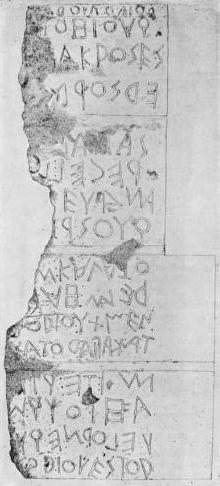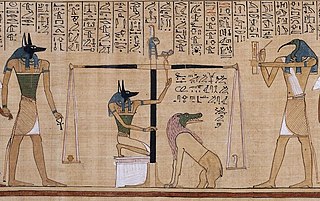
Egyptian hieroglyphs were the formal writing system used in Ancient Egypt for writing the Egyptian language. Hieroglyphs combined logographic, syllabic and alphabetic elements, with more than 100 distinct characters. Cursive hieroglyphs were used for religious literature on papyrus and wood. The later hieratic and demotic Egyptian scripts were derived from hieroglyphic writing, as was the Proto-Sinaitic script that later evolved into the Phoenician alphabet. Through the Phoenician alphabet's major child systems, the Egyptian hieroglyphic script is ancestral to the majority of scripts in modern use, most prominently the Latin and Cyrillic scripts and the Arabic script, and possibly the Brahmic family of scripts.

Boustrophedon is a style of writing in which alternate lines of writing are reversed, with letters also written in reverse, mirror-style. This is in contrast to modern European languages, where lines always begin on the same side, usually the left.

Hieratic is the name given to a cursive writing system used for Ancient Egyptian and the principal script used to write that language from its development in the third millennium BC until the rise of Demotic in the mid-first millennium BC. It was primarily written in ink with a reed pen on papyrus.

Seshat was the ancient Egyptian goddess of writing, wisdom, and knowledge. The daughter of Thoth, She was seen as a scribe and record keeper; her name means "female scribe". She is credited with inventing writing. She also became identified as the goddess of sciences, accounting, architecture, astronomy, astrology, building, mathematics, and surveying.
In punctuation, a word divider is a form of glyph which separates written words. In languages which use the Latin, Cyrillic, and Arabic alphabets, as well as other scripts of Europe and West Asia, the word divider is a blank space, or whitespace. This convention is spreading, along with other aspects of European punctuation, to Asia and Africa, where words are usually written without word separation.

The Book of the Dead is an ancient Egyptian funerary text generally written on papyrus and used from the beginning of the New Kingdom to around 50 BC. The original Egyptian name for the text, transliterated r(ꜣ)w n(y)w prt m hrw(w), is translated as Book of Coming Forth by Day or Book of Emerging Forth into the Light. "Book" is the closest term to describe the loose collection of texts consisting of a number of magic spells intended to assist a dead person's journey through the Duat, or underworld, and into the afterlife and written by many priests over a period of about 1,000 years. In 1842, the Egyptologist Karl Richard Lepsius introduced for these texts the German name Todtenbuch, translated to English as 'Book of the Dead'.

The ankh or key of life is an ancient Egyptian hieroglyphic symbol used to represent the word for "life" and, by extension, as a symbol of life itself.
The djed, also djt is one of the more ancient and commonly found symbols in ancient Egyptian religion. It is a pillar-like symbol in Egyptian hieroglyphs representing stability. It is associated with the creator god Ptah and Osiris, the Egyptian god of the afterlife, the underworld, and the dead. It is commonly understood to represent his spine.

Relief is a sculptural method in which the sculpted pieces remain attached to a solid background of the same material. The term relief is from the Latin verb relevare, to raise. To create a sculpture in relief is to give the impression that the sculpted material has been raised above the background plane. When a relief is carved into a flat surface of stone or wood, the field is actually lowered, leaving the unsculpted areas seeming higher. The approach requires a lot of chiselling away of the background, which takes a long time. On the other hand, a relief saves forming the rear of a subject, and is less fragile and more securely fixed than a sculpture in the round, especially one of a standing figure where the ankles are a potential weak point, particularly in stone. In other materials such as metal, clay, plaster stucco, ceramics or papier-mâché the form can be simply added to or raised up from the background. Monumental bronze reliefs are made by casting.

The Book of Gates is an ancient Egyptian funerary text dating from the New Kingdom. The text was not named by the Egyptians. It was named by French Egyptologist Gaston Maspero who called it 'Livre de Portes'. The Book of Gates narrates the passage of a newly deceased soul into the next world, corresponding to the journey of the sun through the underworld during the hours of the night. The soul is required to pass through a series of 'gates' at different stages in the journey. Each gate is associated with a different goddess, and requires that the deceased recognize the particular character of that deity. Depictions of the judgment of the dead are shown in the last three hours and the text implies that some people will pass through unharmed, but that others will suffer torment in a lake of fire. The Book of Gates serves as a guidebook so that the deceased pharaoh with the sun god, can navigate his way to the afterworld and toward his resurrection. The Book of Gates is long and detailed and consists of one hundred scenes.

Deshret was the Red Crown of Lower Egypt. When combined with the Hedjet of Upper Egypt, it forms the Pschent, in ancient Egyptian called the sekhemti.

In a written or published work, an initial capital is a letter at the beginning of a word, a chapter, or a paragraph that is larger than the rest of the text. The word is derived from the Latin initialis, which means standing at the beginning. An initial is often several lines in height and in older books or manuscripts are known as "inhabited" initials. Certain important initials, such as the Beatus initial or "B" of Beatus vir... at the opening of Psalm 1 at the start of a vulgate Latin. These specific initials in an illuminated manuscript were also called initiums.

The Book of the Earth is an Ancient Egyptian funerary text that has been called many names such as The Creation of the Sun Disk and the Book of Aker. The Book primarily appears on the tombs of Merneptah, Twosret, Ramesses III, Ramesses VI, and Ramesses VII and serves as a counterpart to the Book of Caverns.

The Bull Palette is the fragment of an Ancient Egyptian greywacke palette, carved in low relief and used, at least in principle, as a cosmetic palette for the grinding of cosmetics. It is dated to Naqada III, the final two centuries of the fourth millennium BC, immediately preceding the Early Dynastic Period). It is in the collection of the Louvre, inventory no. E11255.

The lunette spatial region in the upper portion of stelas, became common for stelas as a prelude to a stele's topic. Its major use was from ancient Egypt in all the various categories of stelas: funerary, Victory stelas, autobiographical, temple, votive, etc.
The Paser Crossword Stela is an ancient Egyptian limestone stela that dates from the 20th Dynasty. It was constructed by Paser, c. 1150 BC, during the reign of Pharaoh Ramesses VI.

A writing system comprises a particular set of symbols, called a script, as well as the rules by which the script represents a particular language. Most writing systems can be broadly categorized into alphabets, syllabaries, or logographies. Alphabets use symbols called letters that correspond to spoken phonemes. Abjads generally only have letters for consonants, while pure alphabets have letters for both consonants and vowels. Abugidas use characters that correspond to consonant–vowel pairs. Syllabaries use symbols called syllabograms to represent syllables or moras. Logographies use characters that represent semantic units, such as words or morphemes.
The ancient Egyptian Branch hieroglyph, also called a Stick, is a member of the trees and plants hieroglyphs.
The Egyptian dog Abuwtiyuw, also transcribed as Abutiu, was one of the earliest documented domestic animals whose name is known. He is believed to have been a royal guard dog who lived in the Sixth Dynasty (2345–2181 BC), and received an elaborate ceremonial burial in the Giza Necropolis at the behest of a pharaoh whose name is unknown.
Papyrus Oxyrhynchus 842 is a papyrus manuscript, written in Ancient Greek, discovered during the 1906 excavations in Oxyrhynchus in modern Egypt by Bernard Pyne Grenfell and Arthur Surridge Hunt. It contains a history of classic Greece for the years 396-395 BCE. Along with PSI XII 1304, it makes up the Hellenica Oxyrhynchia.

















